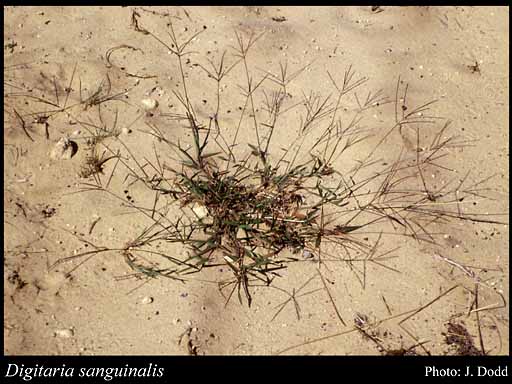- Reference
- Fl.Carniol. Ed.2, 1:52-53 (1771)
- Conservation Code
- Not threatened
- Naturalised Status
- Alien to Western Australia
- Name Status
- Current
Decumbent, tufted annual, grass-like or herb, 0.15-1 m high. Fl. green-purple, Dec or Jan to May. Sand, loam, alluvium.







Distribution
- IBRA Regions
- Avon Wheatbelt, Indian Tropical Islands, Jarrah Forest, Mallee, Swan Coastal Plain, Warren.
- IBRA Subregions
- Katanning, Merredin, Northern Jarrah Forest, Perth, Southern Jarrah Forest, Warren, Western Mallee.
- IMCRA Regions
- WA South Coast.
- Local Government Areas (LGAs)
- Albany, Augusta Margaret River, Bayswater, Boddington, Capel, Christmas Island, Claremont, Corrigin, Cunderdin, Denmark, Joondalup, Kalamunda, Kent, Kulin, Mandurah, Manjimup, South Perth, Swan, Victoria Plains.
Management Notes (for the Swan NRM Region)
Alternative Names. Summer grass, hairy crabgrass.
General Biology. Growth form. Grass. Life form. Annual, caespitose. Reproduction. Seed. Dispersal. Mowing, movement of seed in hay. Photosynthetic Pathway. C4.
Notes. Commonly found in lawns, gardens and disturbed areas. Has association with nitrogen-fixing bacteria. A fungal pathogen has reduced the fecundity of this species in some areas and is a potential candidate for a biocontrol agent. Can release growth inhibitors in root exudates that retards germination and growth of other species. Has recorded herbicide resistance.
Additional information. Origin. North Africa, temperate Asia, tropical Asia, Europe. History of use/introduction. Animal fodder. Similar exotic species. Digitaria ciliaris.
Suggested method of management and control. Small infestations and individual plants can be hand removed by releasing the roots with a knife or trowel, ensure sprawling stems are also removed. Otherwise spray 1% glyphosate in spring. Read the manufacturers' labels and material safety data sheets before using herbicides. For further information consult the Australian Pesticides and Veterinary Medicines Authority to determine the status of permits for your situation or state.
Management Calendar
| Calendar Type | Jan | Feb | Mar | Apr | May | Jun | Jul | Aug | Sep | Oct | Nov | Dec | Comments |
|---|---|---|---|---|---|---|---|---|---|---|---|---|---|
| Active Growth | Y | Y | Y | Y | Y | Y | |||||||
| Flowering | Y | Y | O | O | Y | ||||||||
| Fruiting | Y | Y | Y | ||||||||||
| Optimum Treatment | O | O | O | Y | Y | Y | O |
Legend: Y = Yes, regularly, O = Occasionally, U = Uncertain, referred by others but not confirmed.
References
- Barber, L.E. & Evans, H.J. (1976) Characterization of a nitrogen-fixing bacterial strain from the roots of Digitaria sanguinalis. Canadian Journal of Microbiology, 22: 254-260.
- Brown, K. & Brooks, K. (2002) Bushland Weeds: A Practical Guide to their Management. Environmental Weeds Action Network, Greenwood.
- Chu, J.K.Y. (2005) Digitaria sanguinalis, International Environmental Weed Foundation (IEWF). URL: http://www.iewf.org/weedid/Digitaria_sanguinalis.htm - Accessed January 2009.
- Gallart, M., Masa, T.M. & Verdúa, A.M.C. (2009) Effects of loose smut on Digitaria sanguinalis population depending on seedling emergence period. Acta Oecologica, 35 (3): 409-414.
- Hussey, B.M.J., Keighery, G.J., Dodd, J., Lloyd, S.G. & Cousens, R.D. (2007) Western Weeds. A guide to the weeds of Western Australia. 2nd Edition. The Plant Protection Society of Western Australia, Victoria Park.
- Jiang, S.-J, Qiang, S., Zhu, Y.-Z & Dong, Y.-F. (2008) Isolation and phytotoxicity of a metabolite from Curvularia eragrostidis and characterisation of its modes of action. Annals of Applied Biology, 152: 103-111.
- Masin, R., Zuin, M.C., Otto, S. & Zanin, G. (2006) Seed longevity and dormancy of four summer annual grass weeds in turf. Weed Research, 46: 362-370.
- Parenti, R.L. & Rice, E.L. (1969) Inhibitional effects of Digitaria sanguinalis and possible role in old-field succession. Bulletin of the Torrey Botanical Club, 96 (1): 70-78.
- Salava, J. (2009) Group C1/5 resistant large Crabgrass (Digitaria sanguinalis). International Survey of Herbicide Resistant weeds URL: http://WeedScience.org - Accessed November 2009.
- Swarbrick, J.T. & Skarratt, D.B. (1994) The bushweed 2 database of environmental weeds in Australia. The University of Queensland, Gatton College.
- USDA, ARS, National Genetic Resources Program (2009) Germplasm Resources Information Network - (GRIN). National Germplasm Resources Laboratory, Beltsville, Maryland. URL: https://npgsweb.ars-grin.gov/gringlobal/taxon/taxonomysimple.aspx - Accessed October 2009.